Far Flung and Well Fed by R. W. Apple Jr

Author:R. W. Apple, Jr.
Language: eng
Format: epub
Publisher: St. Martin's Press
Published: 2009-08-14T16:00:00+00:00
Ireland
Much Too Good for a Bagel
It’s a beautiful, beautiful animal,” Frank Hederman said, holding up a silvery 12-pound salmon, bright of eye and red of gill, less than 10 hours out of the sea. “These guys swim 4,000 or 5,000 miles to get here. By comparison, the farmed salmon, the ones who live in those cages off the coast, are essentially goldfish.”
Mr. Hederman smokes fish, which is a little like saying Steinway makes pianos. Savvy fish fanciers in England and Ireland—many of them, anyway—prize his smoked haddock, his smoked eel and especially his smoked wild salmon above all others. Which is what makes you shake your head a bit when you drive up to his place of work.
To get there you cross a small stone bridge onto Great Island, which sits like a cork in the bottle of Cork Harbor. Mr. Hederman, a fit, droll 40-year-old, has lived on the island all his life. You turn right at the evocative remnants of Belvelly Castle, built in the 13th century, towards Cobh (pronounced cove), once called Queenstown. Cobh is the port where hundreds of thousands of nearly penniless emigrants boarded ships in the late 19th and early 20th centuries for North America; it was also the Titanic’s last port of call on her fateful final voyage in 1912.
You’re not headed for Cobh itself, or at least my wife, Betsey, and I weren’t. We turned off the road at a roofless house, with a bunch of ramshackle buildings behind it—just old limestone walls with corrugated metal roofs thrown over them. They had been the kennels for a previous owner’s hunting dogs, Mr. Hederman told us.
But this is about flavor, not architecture, and Mr. Hederman’s salmon has that in spades—a subtle, elegant, elusive flavor, with a slight tang of salt and an uncommon balance between the clean taste of the fish and that of the smoke, which sneaks up on you. The color, a pale, appetizing hue that reminded me of cantaloupe, and the texture, smooth without a hint of oiliness, are equally appealing. The three elements—color and taste and texture—are uniform right through the side.
It took time to get it right. Mr. Hederman rejected, right at the start, the chipboard sawdust many smokers use, because it contains glue particles as well as wood. He tried burning staves from old whiskey barrels, but that, he concluded, deposited too many tars and tannins on the finished product.
Some tarry substances are an integral part of smoking; deposited on the fish, they form a barrier against airborne bacteria, helping to retard spoilage. That has been the main goal of smoking food, as well as drying it, for thousands of years. Flavor is a fringe benefit.
But as he worked amid smoke from the oak, Mr. Hederman found dark stains on his forearms—“like a deep suntan,” he said. Too much tar, he decided, and he switched to beechwood chips, which not only cut down the tars but gave the fish a milder flavor. Each smoker has favorite woods; Bill Casey of Ballycotton imports his from England.
Download
This site does not store any files on its server. We only index and link to content provided by other sites. Please contact the content providers to delete copyright contents if any and email us, we'll remove relevant links or contents immediately.
| Culinary Biographies | Essays |
| Food Industry | History |
| Reference |
For the Love of Europe by Rick Steves(3202)
The Sprouting Book by Ann Wigmore(3052)
BraveTart by Stella Parks(2970)
Better Homes and Gardens New Cookbook by Better Homes & Gardens(2954)
The Death of the Heart by Elizabeth Bowen(2901)
Salt, Fat, Acid, Heat: Mastering the Elements of Good Cooking by Nosrat Samin(2658)
Sauces by James Peterson(2590)
Classic by Mary Berry(2501)
Solo Food by Janneke Vreugdenhil(2494)
The Bread Bible by Rose Levy Beranbaum(2472)
Ottolenghi - The Cookbook by Yotam Ottolenghi(2359)
Martha Stewart's Baking Handbook by Martha Stewart(2331)
Kitchen confidential by Anthony Bourdain(2306)
Betty Crocker's Good and Easy Cook Book by Betty Crocker(2280)
Day by Elie Wiesel(2243)
Hot Sauce Nation by Denver Nicks(2108)
My Pantry by Alice Waters(2041)
The Plant Paradox by Dr. Steven R. Gundry M.D(2039)
The Kitchen Counter Cooking School by Kathleen Flinn(2012)
